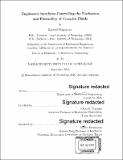Engineered interfaces controlling the nucleation and flowability of complex fluids
Author(s)
Rapoport, Leonid
DownloadFull printable version (19.62Mb)
Other Contributors
Massachusetts Institute of Technology. Department of Mechanical Engineering.
Advisor
Kipa K. Varanasi.
Terms of use
Metadata
Show full item recordAbstract
In recent years, surface engineering has enabled remarkable advances in various fields of fluid mechanics. High mobility of water and even low surface tension fluids was demonstrated using surfaces with engineered chemistry and textures, with driving forces ranging from electrical, magnetic, gravitational, as well as Marangoni forces. Engineered surfaces were also shown to control and improve processes that involve nucleation phenomena such as boiling, condensation, and water collection from moist air. However, when the working fluid contains dissolved media such as salts or all additional fluid, or when it has non-Newtonian properties such as yield stress, the performance of these surfaces may change drastically. This thesis explores how the introduction of complex fluids changes the performance of engineered surfaces, and how these surfaces may be altered to regain their capabilities and expand their range of applicability. We start with yield stress fluids which are ubiquitous in our daily lives (examples ranging from lotions, condiments, grease, etc.) and show how even superhydrophobic surfaces fail to allow these fluids the high mobility they enable water. We show how the special combination of yield stress fluids and Lubricant-Impregnated Surfaces can yield dramatic results allowing these fluids to flow as a plug without shearing. We study the underlying principles that govern this type of mobility, and its limiting cases. We apply these principles to non-aqueous flow batteries and demonstrate how Lubricant-Impregnated Surfaces can increase the capacity of these batteries by up to fourfold by retaining the integrity of their suspended conductive media. We then focus on nucleation and show how the performance of heat transfer surfaces during pool boiling deteriorates when hard salts such as calcium sulfate are dissolved in the liquid. We demonstrate how nucleation of salt crystals from even an undersaturated solution can cause the critical heat flux to decrease by up to threefold. We analyze the cause of this decrease and propose a passive method for restoring the performance of the surface so that the effect of dissolved salts on the critical heat flux is negligible. Apart from salts, the interfacial properties of liquids can also change when other liquids are dissolved in them. By monitoring the motion of bubbles under large thermal gradients, we demonstrate how the liquid-vapor surface tension of a binary mixture of alkanes differ substantially from the corresponding property of its constituents. Furthermore, we show how the liquid-vapor surface tension of these mixtures is non monotonic with respect to temperature and has a maximum (as opposed to self-rewetting fluids) for any mixture ratio. Finally, we use engineered surfaces to capture bubbles. By studying the drainage dynamics of the thin liquid film separating a bubble and a hydrophobic surface, we learn how the textures of a surface affect its ability to capture bubbles. We leverage this understanding to create surfaces with three levels of textures that reduce the capture time of a bubble by two orders of magnitude compared to a flat surface. We then apply this design to create a device that captures bubbles in a foaming solution and prevents foam from forming in a passive and additive-free manner.
Description
Thesis: Ph. D., Massachusetts Institute of Technology, Department of Mechanical Engineering, 2018. Cataloged from PDF version of thesis. Includes bibliographical references (pages 155-166).
Date issued
2018Department
Massachusetts Institute of Technology. Department of Mechanical EngineeringPublisher
Massachusetts Institute of Technology
Keywords
Mechanical Engineering.